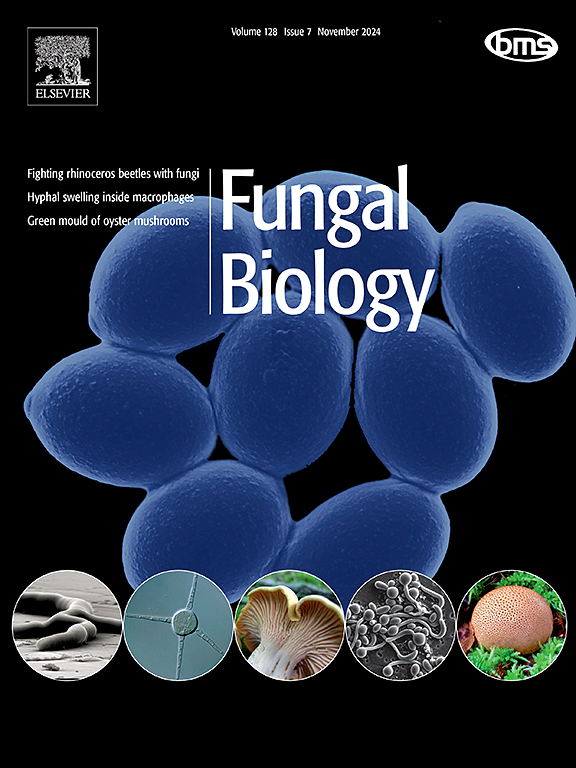花岗岩基质中野生生长的毛囊蘑菇:微量元素吸收和Mg、Cu、Zn和Cd同位素分异
IF 3
3区 生物学
Q2 MYCOLOGY
引用次数: 0
摘要
我们在基质(花岗岩基)-蘑菇(Boletus edulis)体系中研究了微量元素分布(使用Agilent Technologies 5110 ICP-OES)和Mg、Cu、Zn和Cd同位素分选(使用MC-ICP-MS Neptune, ThermoFisher)。B. edulis可能只摄入其健康生存所需的元素,几乎不考虑底物的组成。显著的同位素分异发生在土壤-蘑菇界面(Δ值从Mg的−1.58‰到Cd的+0.72‰不等)。来自花岗岩基基质的B. edulis优先吸收较轻的Mg同位素,而较重的Cu、Zn和Cd同位素优先被吸收。蘑菇内同位素分馏作用不明显。Mg(蘑菇内Δ26Mg =−0.45 ~ +0.35‰)和Zn(蘑菇内Δ66Zn =−0.33 ~ +0.40‰)的蘑菇内同位素分异程度最强,Cu(蘑菇内Δ65Cu =−0.14 ~−0.02‰)和Cd(蘑菇内Δ114Cd =−0.09 ~ +0.08‰)的蘑菇内同位素分异程度最弱。Mg和Zn同位素分馏可能是由于蘑菇的物理性质。在不涉及与氧化还原相关的Cu同位素分馏的情况下,动力学过程和Cu+与S的络合可能导致观察到的蘑菇内Cu同位素分馏的轻微负。非常微不足道的Cd同位素分馏可能是由于尚未确定的真菌驱动的分馏过程。综上所述,本研究证实了毛竹能够吸收不同准备程度的元素,并在子实体内以不同的强度进行转运,使这些元素在不同程度上发生同位素分馏。本文章由计算机程序翻译,如有差异,请以英文原文为准。
The wild-grown Boletus edulis (penny bun) mushroom from the granite-based substrate: Trace elements uptake and Mg, Cu, Zn, and Cd isotope fractionations
We studied trace element distributions (with the use of the Agilent Technologies 5110 ICP-OES) and Mg, Cu, Zn, and Cd isotope fractionations (with the use of the MC-ICP-MS Neptune, ThermoFisher) in a substrate (granite-based)-to-mushroom (Boletus edulis) system. B. edulis likely intakes elements only in amounts necessary for its healthy existence, almost regardless of the composition of the substrate. Significant isotope fractionations occur at the soil-to-mushroom interface (Δ values varied from −1.58 ‰ for Mg to +0.72 ‰ for Cd). B. edulis from the granite-based substrate preferentially took up a lighter Mg isotope, whereas heavier isotopes of Cu, Zn, and Cd are taken up preferentially. Within-mushroom isotope fractionations were not so strongly pronounced. The strongest extent of the within-mushroom isotope fractionation was observed for Mg (within-mushroom Δ26Mg = −0.45 to +0.35 ‰) and Zn (within-mushroom Δ66Zn = −0.33 to +0.40 ‰) whereas the weakest, for Cu (within-mushroom Δ65Cu = −0.14 to −0.02 ‰) and Cd (within-mushroom Δ114Cd = −0.09 to +0.08 ‰). Mg and Zn isotope fractionations could be due to the physical properties of the mushroom. With no redox-related Cu isotope fractionation involved, kinetic processes and Cu+ complexation to S could lead to the observed subtle negative within-mushroom Cu isotope fractionation. Very insignificant Cd isotope fractionation can be due to still unidentified fungal-driven fractionation processes. Overall, the study conducted confirmed that B. edulis is able to uptake elements with different degrees of readiness and translocate them within the fruiting body with differing intensities subjecting the elements to isotope fractionation at different extent.
求助全文
通过发布文献求助,成功后即可免费获取论文全文。
去求助
来源期刊

Fungal biology
MYCOLOGY-
CiteScore
5.80
自引率
4.00%
发文量
80
审稿时长
49 days
期刊介绍:
Fungal Biology publishes original contributions in all fields of basic and applied research involving fungi and fungus-like organisms (including oomycetes and slime moulds). Areas of investigation include biodeterioration, biotechnology, cell and developmental biology, ecology, evolution, genetics, geomycology, medical mycology, mutualistic interactions (including lichens and mycorrhizas), physiology, plant pathology, secondary metabolites, and taxonomy and systematics. Submissions on experimental methods are also welcomed. Priority is given to contributions likely to be of interest to a wide international audience.
 求助内容:
求助内容: 应助结果提醒方式:
应助结果提醒方式:


